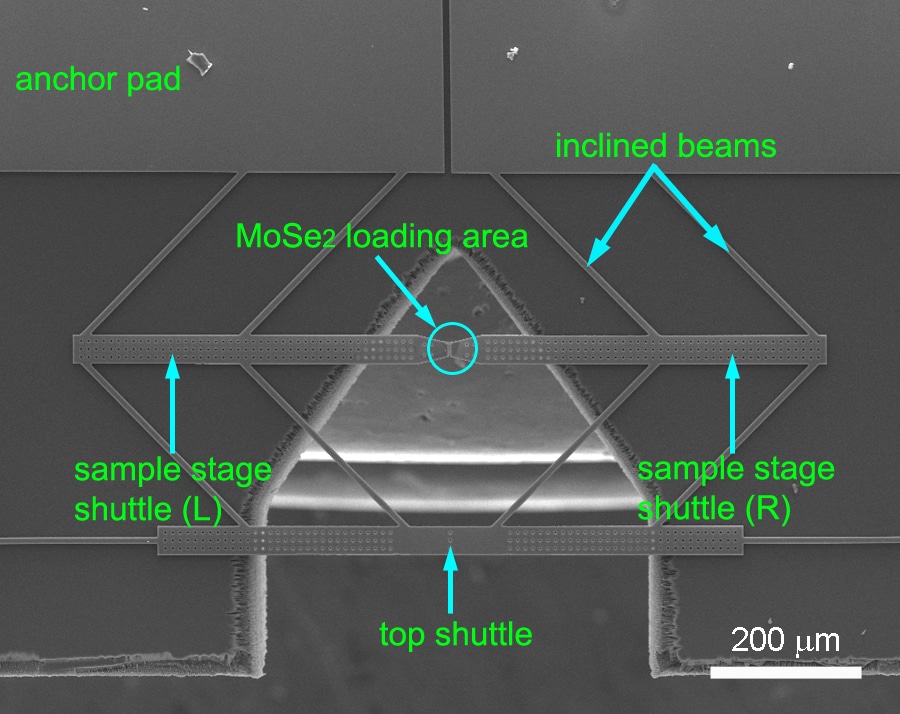Nov 15 2016
 A nanomechanical device designed by Rice University scientists is used to measure the strength of two-dimensional nanomaterials like molybdenum diselenide, the subject of a recent Rice study that found it far more brittle than graphene. Credit: Lou Group/Rice University.
A nanomechanical device designed by Rice University scientists is used to measure the strength of two-dimensional nanomaterials like molybdenum diselenide, the subject of a recent Rice study that found it far more brittle than graphene. Credit: Lou Group/Rice University.
Researchers from Rice University have found that an atom-thick material suggested for use in next-generation optical devices and flexible electronics is more brittle than anticipated.
The Rice group headed by materials scientist Jun Lou analyzed the tensile strength of semiconducting, two-dimensional molybdenum diselenide and found that even a minute defect such as a missing atom can lead to catastrophic cracking under strain.
The findings of the research group will be published in Advanced Materials this month.
Jun Lou said that the outcomes might prompt the industry to cautiously investigate the properties of 2D materials before using them in new technologies.
It turns out not all 2-D crystals are equal. Graphene is a lot more robust compared with some of the others we’re dealing with right now, like this molybdenum diselenide. We think it has something to do with defects inherent to these materials.
Jun Lou, Professor of Materials Science and Nanoengineering, Rice University
He went on to say that the flaws could be as minute as a single atom that creates a vacancy in the crystalline structure.
“It’s very hard to detect them,” he said. “Even if a cluster of vacancies makes a bigger hole, it’s difficult to find using any technique. It might be possible to see them with a transmission electron microscope, but that would be so labor-intensive that it wouldn’t be useful.”
Molybdenum diselenide, a dichalcogenide and a 2-D semiconducting material that looks like a graphene-like hexagonal array when seen from above, originally consists of metallic atoms sandwiched between two chalcogen atom (i.e. selenium) layers. Molybdenum diselenide is being considered for use as transistors and in photodetectors, next-generation solar cells, and catalysts, as well as in optical and electronic devices.
Lou and team measured the elastic modulus of molybdenum diselenide at 177.2 (± 9.3) GPa. The elastic modulus defines the amount of stretching a material can withstand and still return to its original state. However, graphene shows five times more elasticity. They explained that the large deviation could be due to pre-existing defects of between 3.6 and 77.5 nm.
The fracture strength (the extent to which a material can be stretched before breaking) of the material was found to be 4.8 (±2.9) GPa. However, graphene is stronger by nearly 25 times.
Part of the research headed by Yingchao Yang, postdoctoral researcher from Rice University, required the transfer of molybdenum diselenide from the growth chamber of a chemical vapor deposition furnace to a microscope without introducing more flaws. Yang dealt with this challenge by using a dry transfer procedure instead of the standard acid washing that could have destroyed the samples.
Yang analyzed the samples by placing rectangles of molybdenum diselenide on to a highly sensitive electron microscope platform developed by Lou and his team. The samples were held in place by natural van der Waals forces on springy cantilever arms that quantified the applied stress.
Yang said that similar to what they did in an earlier study on graphene, Lou and his team tried to measure the fracture toughness of the material, which is an indicator of the probability of propagation of the cracks. However, the team realized that pre-cutting cracks into molybdenum diselenide caused it to shatter even before the application of stress.
The important message of this work is the brittle nature of these materials. A lot of people are thinking about using 2-D crystals because they’re inherently thin. They’re thinking about flexible electronics because they are semiconductors and their theoretical elastic strength should be very high. According to our calculations, they can be stretched up to 10 percent. But in reality, because of the inherent defects, you rarely can achieve that much strength. The samples we have tested so far broke at 2 to 3 percent (of the theoretical maximum) at most. That should still be fine for most flexible applications, but unless they find a way to quench the defects, it will be very hard to achieve the theoretical limits.
Jun Lou, Professor of Materials Science and Nanoengineering, Rice University
The co-authors of the study include Rice graduate students Emily Hacopian, Weibing Chen, Jing Zhang, and Bo Li; alumna Yongji Gong; and Pulickel Ajayan, chair of Rice’s Department of Materials Science and NanoEngineering, the Benjamin M. and Mary Greenwood Anderson Professor in Engineering and a professor of chemistry; Xing Li of Rice and Peking University, China; Minru Wen of Tsinghua University, China, and the Georgia Institute of Technology; Wu Zhou of Oak Ridge National Laboratory, Oak Ridge, Tennessee; Qing Chen of Peking University; and Ting Zhu of the Georgia Institute of Technology.
The Air Force Office of Scientific Research, the National Science Foundation, the Welch Foundation, the National Science Foundation of China, and the Department of Energy Office of Basic Energy Sciences supported this study.